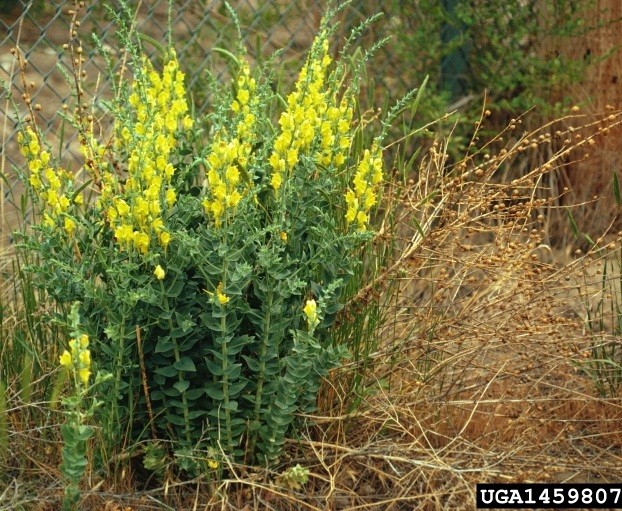Linaria dalmatica
Dalmatian toadflax
Synonym: Linaria genistifolia ssp. dalmatica
Class: Magnoliopsida
Order: Scrophulariales
Family: Scrophulariaceae

Photographer: Utah State University Archive
Source: Bugwood.org
Description
Linaria dalmatica is also known as the wild snapdragon for their strong resemblance to the ornamental cultivars known as snapdragons (Antirrhinum sp.) The flowers are 1 inch long and bright yellow with an orange throat and occur in terminal clusters with the youngest flowers at the tip. Clumps of stems are up to 4 feet tall with waxy ovate, broad or even heart-shaped leaves. Seeds are somewhat flattened, grey and 1/24-1/16 inch wide.
Ecological Threat: Designated a noxious weed in 9 western states and 3 western Canadian provinces. It outcompetes native plants because it has an extensive root system that allows it to thrive in poor conditions and take nutrients away from surrounding plants. Also, some plants can produce up to half a million seeds per plant which allows Linaria dalmatica to vigorously spread and very large monospecific patches. Although cattle avoid grazing this plant, Dalmatian toadflax contains a poisonous glucoside harmful to cattle if consumed in large quantities.
Biology: Linaria dalmatica can produce by seeds or vegetatively through rhizomes. Seedling emerge around March and first year seedling usually produce prostrate shoots that allow the plant to survive from the fall until the next spring. Each plant can produce an exorbitant amount of seeds allowing the populations to grow quickly. Roots can grow as deep and wide as 10 feet both ways. Rhizomes allow the plants to re-sprout from cut roots which also contributes to their quick growing ability; and why they are difficult to manage with just mechanical strategies.
History: Imported as an Ornamental in 1874, for use in fabric dye and medicinal purposes.
U.S. Habitat: Disturbed areas such as roadsides; and degraded areas such as abandoned lots and fields, clearings, over grazed rangelands and even gravel pits.
Distribution
Native Origin: Dalmatian coast of the Adriatic Sea from Slovenia to Greece and Iraq.
U.S. Present: AR, AZ, CA, CO, CT, IA, ID, IL, IN, KS, MA, ME, MI, MN, MT, ND, NE, NH, NJ, NM, NV, NY, OH, OK, OR, PA, RI, SD, UT, VT, WA, WI and WY
Resembles/Alternatives
Other toadflax species especially the invasive Yellow Toadflax (Linaria vulgaris) but Dalmatian toadflax is larger and has differently shaped leaves
Management
All toadflax species are very difficult to control and require integrated management strategies. These plants have a very robust root system and produce a very large number of seeds making management a labor intensive process. Herbicides that have picloram, chlorsulfuron or imazapic can be effective after repeated or combined treatments; however, each herbicide needs to be applied within a certain growth period and can take years before they are fully effective.
There are biological controls being studied for the management of toadflaxes one of them is the weevil Mecinus janthinus. In the field, this beetle has shown promise in reducing seed production by 50-70%. Larvae cause the physical injury to the plant while the adults reduce seed production. Further studies are required but so far this weevil shows potential and a biological control of a very noxious weed.
Text References
Alex, J. F. 1962. The taxonomy, history, and distribution of Linaria dalmatica. Canadian Journal of Botany 40(2): 295-307.
Internet Sources
http://www.fs.fed.us/rm/pubs_other/rmrs_2005_wilson_l001.pdf
http://www.mtweed.org/dalmatian-toadflax/
http://wiki.bugwood.org/HPIPM:Dalmatian_toadflax
http://www.ext.colostate.edu/pubs/natres/03114.html
.
 Texas Invasive Species Institute
Texas Invasive Species Institute